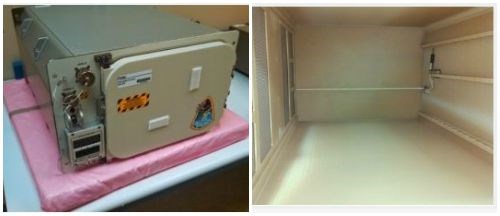3D Printing for Space Station Freezer Interior
For a freezer to be used in orbit, growing the interior structure in one piece eliminates joining and brackets to maximize the space efficiency of this space-borne appliance.

A 3D printing material known for its resistance to heat is being used in an application of continuous –80°C cold on the International Space Station. Fused deposition modeling (FDM) with Ultem 9085 material replaced conventional manufacturing with PEEK in the production of the liner for the “Polar” freezer transporting scientific samples into space.
The University of Alabama Birmingham Center for Biophysical Sciences & Engineering created the freezer. The challenge facing the team working on it was to make the freezer more space-efficient compared to previous designs. Machining flat pieces of PEEK and joining them created sharp corners that fit poorly in the rounded interior of the freezer unit. Thermoforming the liner in PEEK to match the curves necessitated the use of brackets and joining features, which also compromised space-efficiency.
When the team turned to 3D printing, mechanical engineer Daniel Sealy says the group was intially still thinking about it like conventional processes, expecting to have to grow several pieces and connect them together. However, Stratasys Direct Manufacturing was able to apply a large-platform FDM machine to build the freezer’s entire liner assembly in one piece. Freezers using the liner arrived at the International Space Station earlier this year.
Read a more detailed article from Stratasys Direct Manufacturing.
And speaking of additive … our Additive Manufacturing brand is about to grow. Soon, we will launch a new website devoted to additive manufacturing for industrial applicatons, and we will expand the publication that began as a small supplement into a full-size magazine. All of this will happen later this year. For now, stay apprised of these and other additive developments (and also give us a little encouragement) by joining us as one of the earliest followers of Additive Manufacturing on Facebook, Twitter and LinkedIn.
Related Content
-
3D Printed Titanium Replaces Aluminum for Unmanned Aircraft Wing Splice: The Cool Parts Show #72
Rapid Plasma Deposition produces the near-net-shape preform for a newly designed wing splice for remotely piloted aircraft from General Atomics. The Cool Parts Show visits Norsk Titanium, where this part is made.
-
3D Printed Preforms Improve Strength of Composite Brackets: The Cool Parts Show Bonus
On this episode, we look at a pin bracket for the overhead bin of an airplane made in two composite versions: one with continuous fiber 3D printed reinforcements plus chopped fiber material, and one molded from chopped fiber alone.
-
5 Ways Collaborative Robots and 3D Printing Go Together
Collaborative robots (cobots) are seemingly everywhere — a defining automation technology today. And cobots have a relationship with additive manufacturing that is, well, collaborative. While cobots need custom hardware AM can provide, they are well suited to aid AM production. Here is just some of what we have seen of the interaction between cobots and 3D printing.















